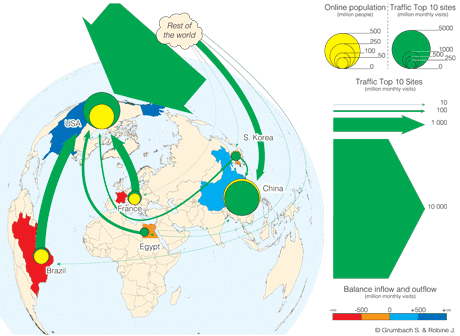Intermediation platforms connect people, services and even things in ways that have been unthinkable until now. Search engines provide relevant references for people searching for information. Social networks connect users in their environment. Car pooling systems link drivers and passengers using the same routes. Intermediation platforms use big data to fuel the services they offer and these services are evolving extremely quickly but almost unnoticed. They are already competing with the oil industry as the world’s top market capitalisations and are on the verge of revolutionising the world in which we live.
Intermediation platforms can connect people, services or things that share common or complementary interests and would benefit from knowing one another. It can be either users that seek out such connections or the platform itself which takes the initiative to suggest connections. The relevance of the intermediation, which relies on sophisticated algorithms and agile business models, ensures the success of the services provided by the platforms [1].
The first intermediation platforms that were deployed at a very large scale were search engines. Introduced in the late 1990s, the primary purpose of search engines is to connect people with the information they are looking for. Meanwhile their business model relies on their secondary service which is effectively targeting ads to users. Search engines rely on very complex algorithms to rank the data and provide relevant answers to queries. In the last decade, intermediation platforms have successfully penetrated an increasing number of sectors, mostly in the social arena.

Figure 1: An estimate of data flows between representative countries (as indicated by the arrows) that have been harvested online from the top ten websites in each country of origin. These websites represent about a third of the total activity of the entire top 500 sites. It is interesting to note that the US is clearly harvesting most of the data generated by most countries, including those in Europe.
All intermediation platforms essentially rely on the same architecture. To begin with, they collect huge amounts of data which can come from the outside world (e.g., web pages for search engines) or be hosted by the platform (e.g., social networks). However, they are never produced by the platform itself but rather, by the people, services or things around it. These primary data are then indexed and transformed to extract information that fuels the primary services offered.
The activities of users on platforms generate secondary data. This secondary data essentially consists of traces which the platform generally has exclusive rights to, and allow the platform to create secondary services. A key example of this is the precise profiling of users which permits personalised and customised services: personal assistants trace users as they go about their day-to-day activities, not only online but also in the physical world through the use of geo-localization or quantified-self means.
Beyond personal services, platforms also generate data that can be of tremendous importance for virtually anything, for example, the information provided by search trends on search engines. Interestingly, it is hard to predict what uses this data might have and surprising applications of big data are emerging in many sectors. For instance, in the US, road traffic data from Inrix could reveal economic fluctuations before government services, much like Google Flu was ahead of the Centre for Disease Control. The externalities of big data, both positive and negative, need to be thoroughly considered and this is the goal of the European project BYTE [2], launched this year.
Platforms create ecosystems in which both users and economic players take a role. Platforms follow two rules: (i) they perform a gatekeeper role, acting as intermediaries for other services their users require and removing the need for other middleman; and (ii) they facilitate the easy development of services on their API for economic players. These two rules are fundamental to ensuring their capacity to collect data: this data then fuels all their services.
Platforms now have important economic power that rivals energy corporations. They offer services which have become essential utilities and are indispensable, not only for the general public but corporations as well. This latter group have come to rely on the services of platforms to facilitate customer relations and other fundamental aspects of their businesses. Like other essential utilities, such as water, energy and telecommunications, platforms provide service continuity, are non-discriminatory and can adapt to changes. Their business model is two-sided, with users on one side who receive free access to services and on the other side, clients (who at this stage mostly consist of advertisers) that can access special services offered to them.
In addition to offering brand new services, platforms are also disrupting [3] existing services by changing the rules of the game. By giving users easy access to a wide choice of possible services, platforms empower consumers. At the same time, they weaken traditional service providers. For instance, in the press, platforms allow users to access content from multiple sources. Such integrators might rely completely on algorithms and thus, bypass in-house journalists. In addition, by taking into account their reading habits or declared interests, platforms can offer a customised experience for their readers. This revolution is progressively taking place in all aspects of the content industry, including publishing, mass media, etc. This level of influence is not unique: there is hardly a sector that involves people, services or things that isn’t or wont be affected by platforms. Platforms are abolishing the distinction between service providers and consumers. Currently, the transportation and the lodging sectors are experiencing seriously impacts. This will soon be the case of media channels. States often react by trying to protect the suffering economic sectors.
Platforms empower people, but weaken establishments. By taking control of an increasing number of services, they also weaken States by disrupting the traditional economy and generating revenue for both users and the platform itself that escape taxation. To respond to this, tax systems must be reinvented. However, platforms also hold fantastic potential for meeting one of society’s most important challenges, the more frugal use of resources.
Platforms are on the verge of redesign the world as we know it. They not only introduce incredible promise, but also considerable challenges. To date, no platforms have been developed in Europe and consequently, its dependency on US platforms increases every day. This means that much of the European data harvested online is flowing to the US and with it an increasing loss of business opportunities and control over local activities.
Link:
BYTE project: http://byte-project.eu
References:
[1] S. P.Choudary: “Platform Thinking, The New Rules of Business in a Networked World”, http://platformed.info/
[2] S. P. Choudary, G. Parker and M. Van Alstyne: “Outlook 2014: Platforms are Eating the World”, http://www.wired.com/2013/12/outlook-2014-platforms-eating-world/
Please contact:
Stéphane Grumbach
Inria, France
E-mail:
https://who.rocq.inria.fr/Stephane.Grumbach
@SGrumbach











